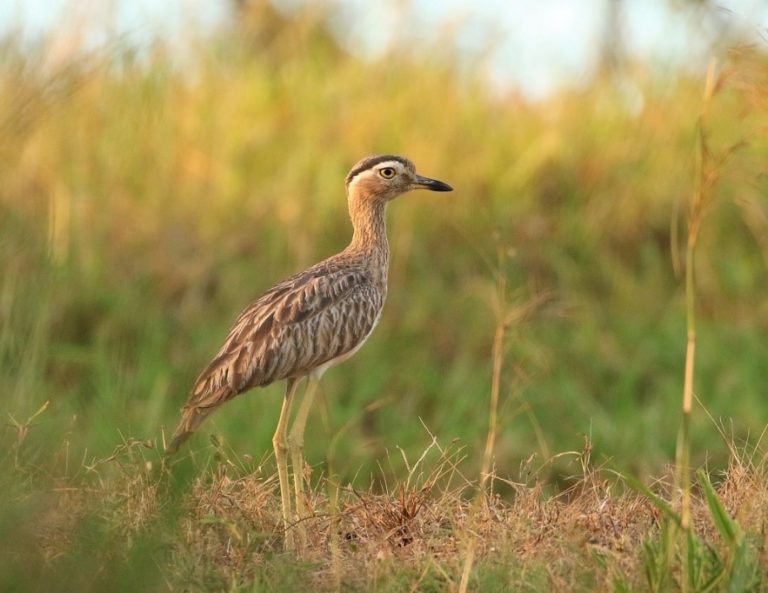Birdfinding.info ⇒ Locally common in some areas, especially the Llanos of Colombia and Venezuela. In northern Colombia, Los Flamencos Wildlife Refuge is a reliable site. In Mexico, it is especially common in eastern Tabasco and on the Pacific side of the Isthmus of Tehuantepec. In Central America, it can be found at many sites in the dry Pacific lowlands from Choluteca, Honduras, to northwestern Costa Rica (including Santa Rosa, Palo Verde, and Carara National Parks). Scarce in the D.R., but it can often be found at Monte Plata.
Double-striped Thick-knee
Burhinus bistriatus
Savannas and brushlands of Middle America, the West Indies, and northern South America.
Occurs on Mexico’s Gulf Coast plains from Tamaulipas to Campeche, and on the Pacific slope from southern Oaxaca to southern Costa Rica. Also present in many interior valleys of El Salvador, Honduras, and western Nicaragua.
In the West Indies, it occurs locally on Hispaniola from northernmost Haiti east across the northern and eastern lowlands of the Dominican Republic. It also appears to have colonized Great Inagua, where breeding has been confirmed on a handful of occasions since 2003.
Its South American range encompasses the Caribbean lowlands of northern Colombia and Venezuela (including Isla Margarita) east to the Orinoco Delta and south throughout the Llanos of both countries and the savaanas of western Guyana and northern Roraima. There is a separate population in eastern Amapá.
Movements. Non-migratory, but dispersive and prone to wandering. It appears to be expanding its range in several areas: north along Mexico’s Gulf Coast plains where there are recent records from northern Tamaulipas; from Hispaniola to Great Inagua; south along the Pacific Coast of Costa Rica and into Colombia’s Cauca and Magdalena valleys; and east onto Trinidad, where it may already be a rare permanent resident.
There are additional extralimital records from: Ceará, Curaçao (July 1934), Tobago, and Texas (immature female collected in Kleberg County, December 5, 1961).
Identification
The only thick-knee in its range, giving the impression is of a giant plover with long legs and large yellow eyes.
Mottled brown above, with a white belly. Broad blackish stripes on the crown contrast with long, bold white eyebrows.
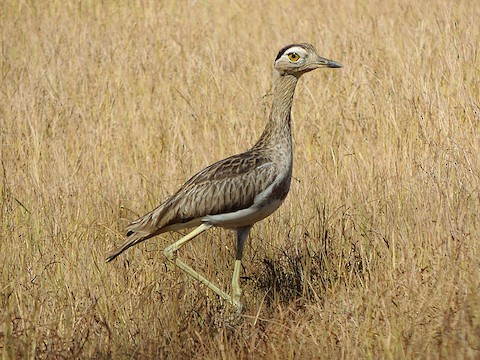
Double-striped Thick-knee. (Ensenada Lodge, Puntarenas, Costa Rica; March 7, 2015.) © Richard Garrigues
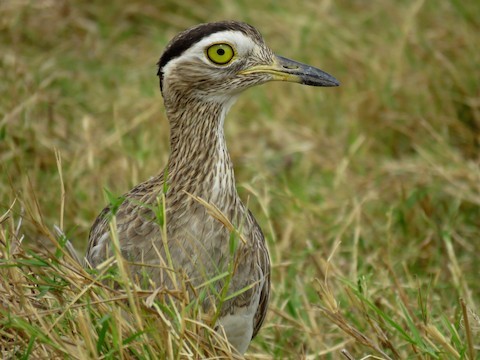
Double-striped Thick-knee, showing the boldness of its facial pattern. (Finca El Jiote, Choluteca, Honduras; February 3, 2018.) © John van Dort

Double-striped Thick-knee. (Playa Agujas Road, Puntarenas, Costa Rica; April 7, 2014.) © Tom Benson
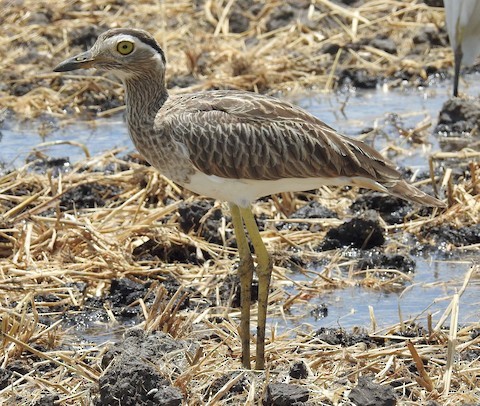
Double-striped Thick-knee, in a muddy pasture. (Arrocera del Valle, Matagalpa, Nicaragua; September 6, 2018.) © Danilo Moreno
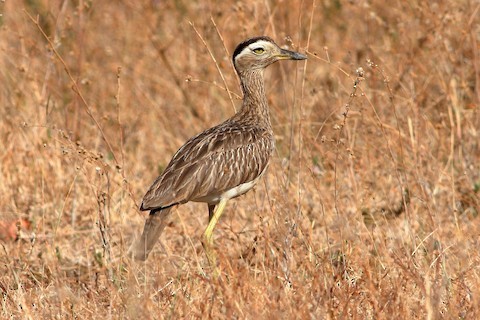
Double-striped Thick-knee, showing bustard-like form. (Las Palmitas, Rivas, Nicaragua; April 13, 2019.) © Manfred Bienert

Double-striped Thick-knee, blending into dry grass. (Alvarado, Veracruz, Mexico; May 4, 2019.) © iturriagal
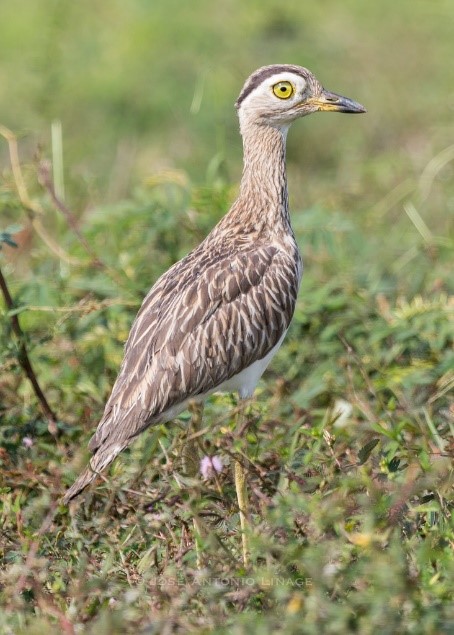
Double-striped Thick-knee, showing its bright yellow saucer of an eye. (Palizada Campeche, Mexico; December 2, 2016.) © José Antonio Linage Espinosa
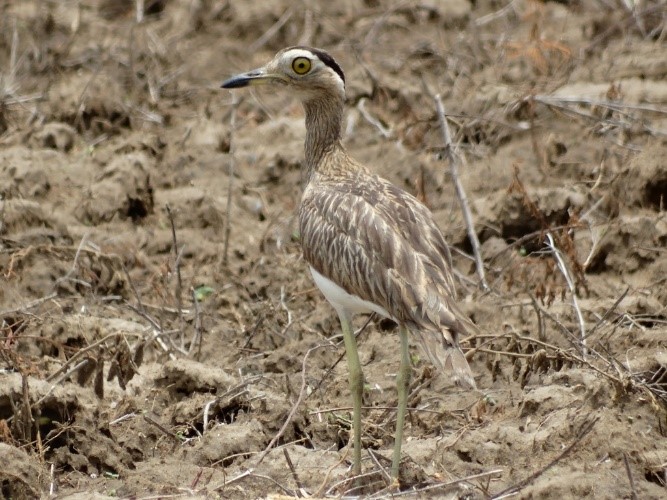
Double-striped Thick-knee, showing the effectiveness of its camouflage. (San Pedro Comitancillo, Oaxaca, Mexico; May 28, 2014.) © Juan Rafael Rodríguez Razgado

Double-striped Thick-knee, showing its strikingly long legs and tall form. (Reserva El Jicarito, Choluteca, Honduras; September 4, 2016.) © John van Dort

Double-striped Thick-knee. (Finca El Jiote, Choluteca, Honduras; February 1, 2017.) © Roselvy Juárez
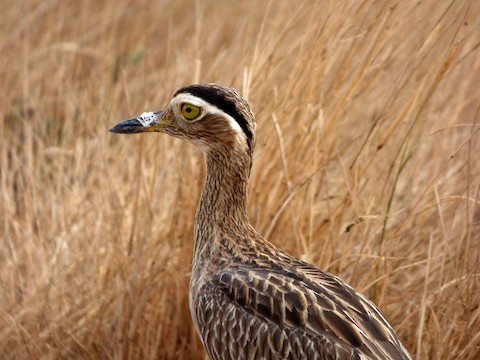
Double-striped Thick-knee, showing the boldness of its facial pattern—close-up view of individual in previous photo. (Finca El Jiote, Choluteca, Honduras; February 1, 2017.) © Roselvy Juárez
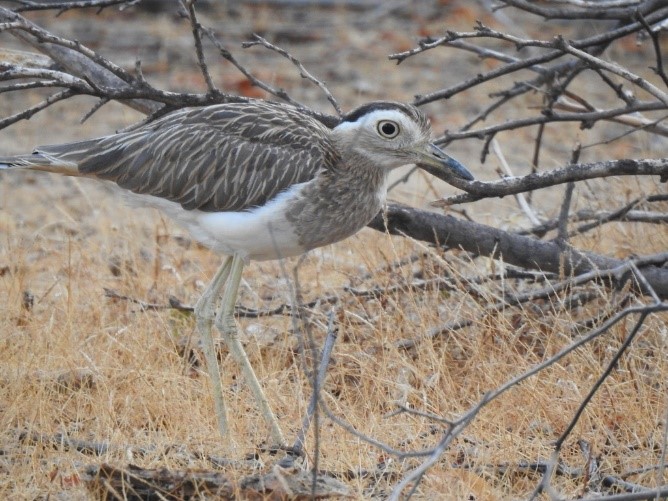
Double-striped Thick-knee. (Maicao, La Guajira, Colombia; May 31, 2019.) © Ricardo Alvarez Zamora

Double-striped Thick-knee, patrolling a fenceline. (Boa Vista, Roraima, Brazil; January 15, 2013.) © Ingrid Macedo
In flight, the upperside of the wing shows largely black flight feathers with a bold white patch at the base of the primaries. The underside of the wing is mostly white.

Double-striped Thick-knee, showing the isolated white patch at the base of the primaries. (Santa Cruz Minas, Santa Bárbara, Honduras; February 5, 2017.) © Francisco Dubón
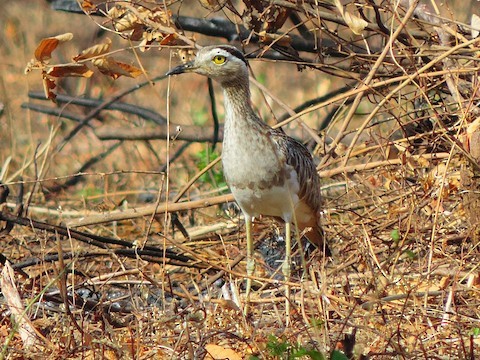
Double-striped Thick-knee, frontal view. (Escamequita, Rivas, Nicaragua; March 19, 2014.) © Luis Diaz
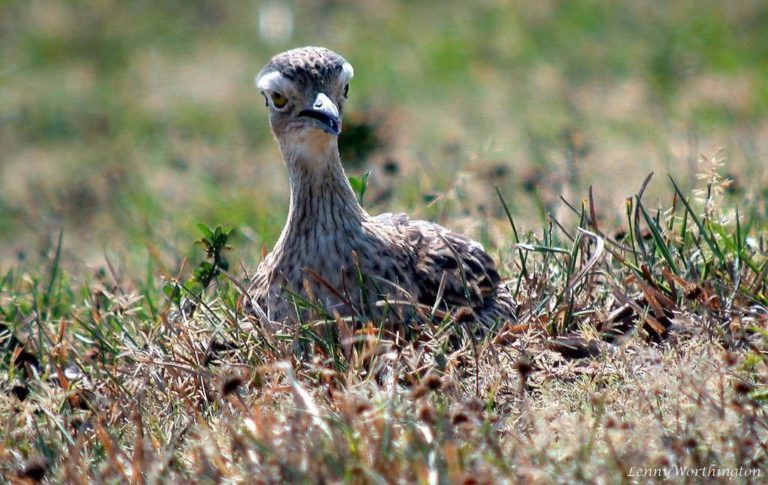
Double-striped Thick-knee, on nest, giving a frontal view of its peculiarly broad head. (Los Llanos, Venezuela; January 19, 2005.) © Leonard Worthington
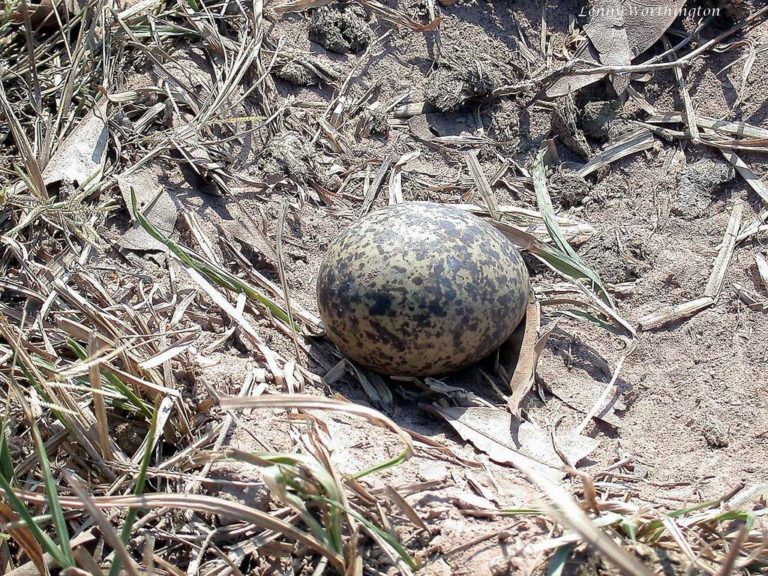
Double-striped Thick-knee, nest. (Los Llanos, Venezuela; January 19, 2005.) © Leonard Worthington
Cf. Peruvian Thick-knee. Double-striped’s closest relative, the Peruvian Thick-knee, is similar overall, but has grayer, less streaked upperparts. There is no known overlap between them.
Notes
Polytypic species consisting of four recognized subspecies.
References
Ascanio, D., G.A. Rodriguez, and R. Restall. 2017. Birds of Venezuela. Christopher Helm, London.
BirdLife International. 2016. Burhinus bistriatus. The IUCN Red List of Threatened Species 2016: e.T22693594A93414735. http://dx.doi.org/10.2305/IUCN.UK.2016-3.RLTS.T22693594A93414735.en. (Accessed September 22, 2019.)
eBird. 2019. eBird: An online database of bird distribution and abundance. Cornell Lab of Ornithology, Ithaca, N.Y. http://www.ebird.org. (Accessed September 22, 2019.)
Fagan, J., and O. Komar. 2016. Peterson Field Guide to the Birds of Northern Central America. Houghton Mifflin Harcourt, New York.
ffrench, R. 2012. A Guide to the Birds of Trinidad & Tobago (Third Edition). Cornell University Press, Ithaca, N.Y.
Garrigues, R., and R. Dean. 2014. The Birds of Costa Rica: A Field Guide (Second Edition). Cornell University Press, Ithaca, N.Y.
Howell, S.N.G., I. Lewington and W. Russell. 2014. Rare Birds of North America. Princeton University Press, Princeton, N.J.
Howell, S.N.G. and S.W. Webb. 1995. A Guide to the Birds of Mexico and Northern Central America. Oxford University Press, Oxford.
Hume, R., and G.M. Kirwan. 2017. Double-striped Thick-knee (Burhinus bistriatus). In Handbook of the Birds of the World Alive (J. del Hoyo, A. Elliott, J. Sargatal, D.A. Christie, and E. de Juana, eds.). Lynx Edicions, Barcelona. https://www.hbw.com/node/53770. (Accessed September 22, 2019.)
LaBarbera, K. 2010. Double-striped Thick-knee (Burhinus bistriatus), version 1.0. In Neotropical Birds Online (T.S. Schulenberg, ed.). Cornell Lab of Ornithology, Ithaca, N.Y. https://doi.org/10.2173/nb.dstkne.01.
Latta, S., C. Rimmer, A. Keith, J. Wiley, H. Raffaele, K. McFarland, and E. Fernandez. 2006. Birds of the Dominican Republic and Haiti. Princeton University Press, Princeton, N.J.
Marchant, J., T. Prater, and P. Hayman. 1986. Shorebirds: An Identification Guide to the Waders of the World. Houghton Mifflin, Boston.
McMullan, M., and T. Donegan. 2014, Field Guide to the Birds of Colombia (Second Edition). Fundación Proaves de Colombia, Bogotá.
Raffaele, H., J. Wiley, O. Garrido, A. Keith, and J. Raffaele. 1998. A Guide to the Birds of the West Indies. Princeton University Press, Princeton, N.J.
van Perlo, B. 2009. A Field Guide to the Birds of Brazil. Oxford University Press, Oxford.
Wells, J.V., and A.C. Wells. 2017. Birds of Aruba, Bonaire, and Curaçao. Cornell University Press, Ithaca, N.Y.
WikiAves, Téu-téu-da-savana, http://www.wikiaves.com.br/teu-teu-da-savana
